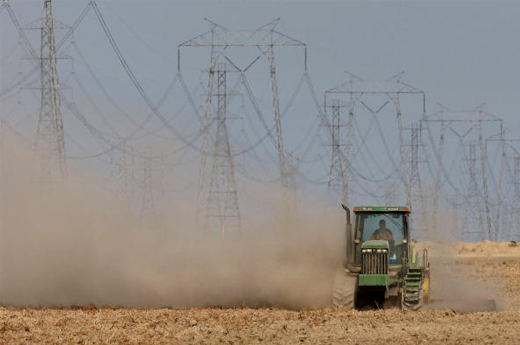
by guest blogger Deirdre Imus, author and environmental health advocate
Maybe you’ve heard about the ongoing drought in California. Maybe you haven’t because you don’t live there, and you think that a lack of water in one state has nothing to do with the 49 others. But we’d all be wise to pay close attention to the severe precipitation shortage in California, which recently prompted Governor Jerry Brown to declare a statewide drought emergency.
The National Drought Mitigation Center at the University of Nebraska–Lincoln defines a drought as a deficiency of precipitation over an extended period of time—usually a season or more—resulting in a water shortage for some activity, group, or environmental sector. A drought’s impact results from the interplay between the natural event (less precipitation than expected) and the demand people place on the water supply.
According to the United States Census Bureau, the population of California is 38.4 million, the largest in the country. That’s a lot of people, demanding a lot of water. And California is not alone in its suffering: The New York Times reported earlier this month that farmers in Nevada had given up on planting, and ranchers in New Mexico were selling off cattle because fields of grass normally four feet high were brown and dry.
Parts of California are faring better than others during this drought. Communities in Southern California, for instance, learned from previous droughts and have taken dedicated steps toward conserving the region’s water supply for decades now. Rebate programs offer incentives for residents to install low-flow showerheads, new toilets that use less water than older models, and sprinkler systems that respond to weather and plant conditions. Additionally, Southern California has beefed up its water storage capacity over the past decade, according to the Los Angeles Department of Water and Power.
As a result, the State Water Project’s announcement that it can no longer supplement dwindling water supplies throughout California is of less concern around Los Angeles, where one local water official told Time.com, “If it stopped raining everywhere in the West, we still have a year and half of water supply.”
Whether you live somewhere prone to drought or not, limiting water usage is a good environmental practice. Installing high-efficiency washing machines and dishwashers in your home conserves large amounts of water; so does simply fixing a leaky toilet. For more easy ways to reduce water consumption at home or at work, check out the Environmental Protection Agency’s WaterSense website.
Droughts have legs, with wide-reaching, long-lasting effects. An article posted last year on Slate.com pondered what the American diet would look like without California, which produces a sizeable majority of this country’s fruits, vegetable, and nuts. More than 90 percent of our artichokes, walnuts, kiwis, plums, celery, and garlic are grown in California. The list of vital, nutritious vegetables dependent on California’s particular climate and soil is extensive. The ability to grow and foster most crops relies, obviously, on water. A water shortage portends a food shortage, which we’ll all pay for at the grocery store if produce prices surge.
A freakishly dry weather pattern, combined with human and other factors, has led to California’s worst drought in centuries. Such “freak” events seem to be happening more regularly—Hurricane Sandy on the East Coast, historic floods in the Midwest, raging wildfires in the West. There’s no telling when this situation in California will improve, but as state and federal officials grapple with this emergency, we should all consider ourselves affected until it is proven otherwise.
 Deirdre Imus, founder of the site devoted to environmental health, dienviro.org, is president and founder of The Deirdre Imus Environmental Health Center at Hackensack University Medical Center and cofounder/codirector of the Imus Cattle Ranch for Kids with Cancer. She is a New York Times best-selling author and a frequent contributor to FoxNewsHealth.com and Fox Business Channel.
Deirdre Imus, founder of the site devoted to environmental health, dienviro.org, is president and founder of The Deirdre Imus Environmental Health Center at Hackensack University Medical Center and cofounder/codirector of the Imus Cattle Ranch for Kids with Cancer. She is a New York Times best-selling author and a frequent contributor to FoxNewsHealth.com and Fox Business Channel.
Adapted from a previously published post.




I would like to note that the water in Las Angeles is mostly not from that area. It is transported from Northern California and I think the Colorado River. I’m glad that they are doing everything are doing, but they are still too many people living in a desert.
Also, the communities along the coast tend to use less water than those in the central part of the state. The majority of water is used by agriculture. We would fare better if as much as possible people in other states and countries ate local foods.
I think too… there is the big question we all need to ask..such as DO we need swimming pools- think of the amount of water used to fill each one,, am sure there are many other examples…. in light of the drought, people really need to ask themselves, what is important and what can we live without .. how can WE start to conserve and save the environment- diverting water for human needs- also takes away water from nature and changes habitats.
There is no reason for snack time to undermine your efforts to follow a healthy diet. Some “diet” foods are higher in calories than you might think.